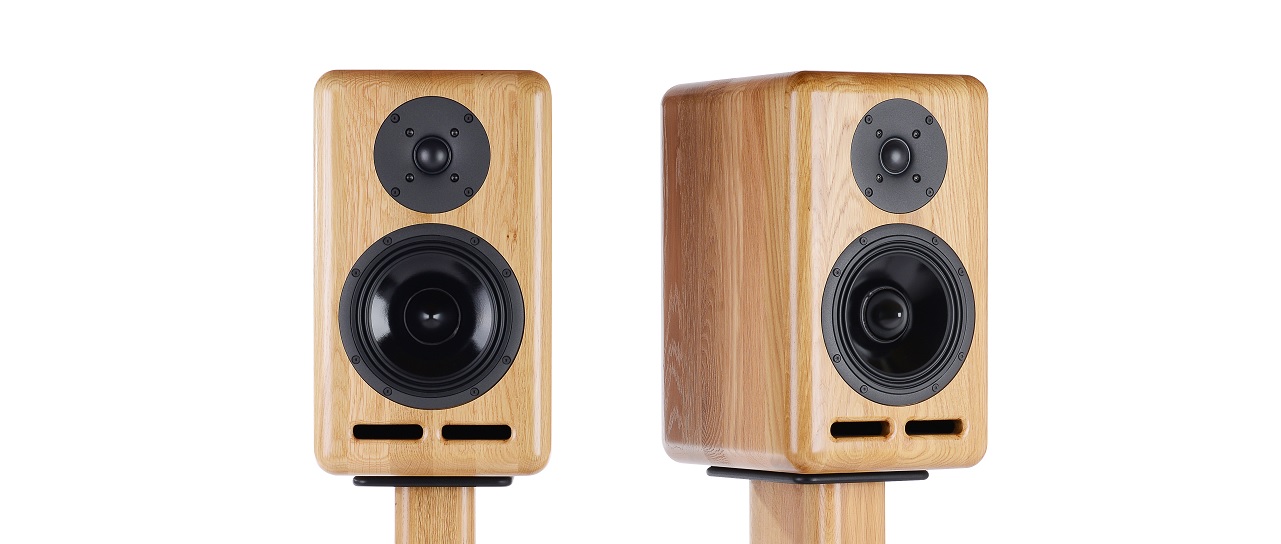In the House, with David Neice
Test Review of the Xavian Premio (Esclusivo) Standmount Speakers
MSRP (as tested): | Speakers $6195 | Stands $1295 | (Canadian)
Currently offered at an introductory price of $4895 and $995.
See also – https://stereo-untypical.com/xavian
Disclosure: These speakers were reviewed while on loan from their importer and Canadian retailer, Noam Bronstein, at Stereo Untypical. Noam is also the publisher of ‘Wall of Sound’, and special care was taken to ensure that he did not influence the contents of this review. Having said that, I should also mention that I will definitely miss them when they return to Stereo Untypical.
Verdict: These are terrific speakers for medium to larger sized rooms. When positioned in a room with lots of open space they will delightfully surprise you by delivering a wide and full soundstage that envelops the whole room in organic and coherent sound. Their forte is rhythmic drive and pace. If I was planning to hold a big happy party in a ‘great room’, then I would want these speakers working hard to activate a feeling of joyous fun.
First Impressions
My body is moving and my legs are bobbing up and down with the beat. My mind is racing; what will I play next? It has got to be some danceable music; something wiith a strong rhythmic drive. M People – that is perfect. I put on the CD and let the volume rip and the whole room is shaking. I am up and dancing and this is me – a 73 year old guy! It’s the Xavian Premios that have me up on my ancient feet.
Suddenly the decades have melted away and I want to ‘twist again’. I think again – hell, yes – Chubby Checker has to be next. That’s just perfect. He made some of the most infectious dance music ever waxed. I put Chubby on and I am in heaven and it’s those Xavian Premios that are responsible for all this.
Can stereo speakers actually be fun? I think so. The audiophile world is generally a pretty sober place with lots of anal-like OCD and repression wafting around the corridors. I get that and have to fight my own OCD like a plague. All the more reason I think to be surprised when a speaker comes along that just puts a large dollop of fun in your life and a big smile on your face. So let’s look more closely at the Xavian Premios and sort out their origins and attributes.
The basic design and so on
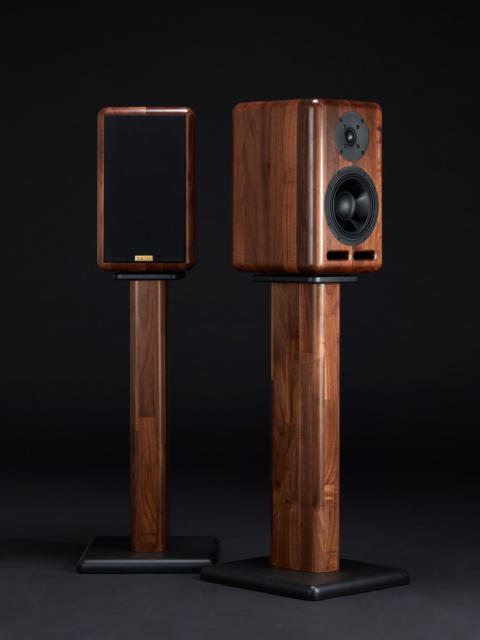
These are two way stand mount speakers that are sold with matching integrated stands as an extra option. The speaker is bolted firmly to the stand. They are front ported and made of solid dense oak wood. Each pair is made to order. In that regard they are what is called in Europe a ‘bespoke’ item, similar to a custom made men’s suit or a finely crafted and engraved Italian shotgun.
They are made in Prague, Czech Republic, employing old world cabinetry and craftsmanship and are designed by an Italian audio engineer, Roberto Barletta. All drivers used in Xavian speakers are made in Milan to Barletta’s specification.
The Premios are at the top of the ‘Natura’ line of speakers which Xavian manufactures. Their cabinet dimensions are 386 X 276 X 230 mm rendering them a gross volume of less than twenty litres. They are rated at eight ohms impedance and are 87 db efficient. Further technical information is available at the end of this review.
Two way speaker designs present a series of routine challenges to any designer. You need to find a means to elicit sufficient bass response from the enclosure as well providing a tuneful mid-range in about a 12 to 20 litre box that will still provide the superior image precision or ‘point source effect’ that a small speaker cabinet naturally provides.
I like to see what designers come up with to meet that challenge and therefore I far prefer two way stand mount designs to other configurations. This is not to say that they are inherently better than other speaker configurations, but only that I understand the issues a two way designer faces more completely.
To date, the Xavian Perla speakers, a smaller Xavian two way design, has been reviewed favourably by no less than nine publications. So the purpose of this review is to shed some needed light on the larger Premios and hopefully restore some balance in the face of all the press attention being paid to the Perlas.
Sturdy and strong

First off, these are quite heavy and exceptionally sturdy speakers. The speaker cabinets are pieced from slabs of solid oak and finished to a high degree of polish like old world finely crafted furniture. The stands are very modern and are sculpted and finished to closely match the speaker cabinets. The speaker and stand pairing has a quite strikingly handsome appearance that should please any fussy owner.
I have not seen solid wood speaker cabinets for some years. The last widely admired samples were made by John Szabo in Cambridge Ontario and were also crafted from oak. The wood used in the Xavian is referred to by the manufacturer as ‘mosaic’ oak. By that is meant that the cabinets are made of sandwiches of oak pieces, using the methods by which a high quality cutting board woud be constructed.
The finish on this pair is light oak but other natural wood and gloss finishes are possible. The walls of the cabinets appear to be quite thick and the specification is 23 mm or about an inch thick. The density of the wood sides and top means that when you tap the cabinet there is little to no resonance.
Bolted stands are decoupled
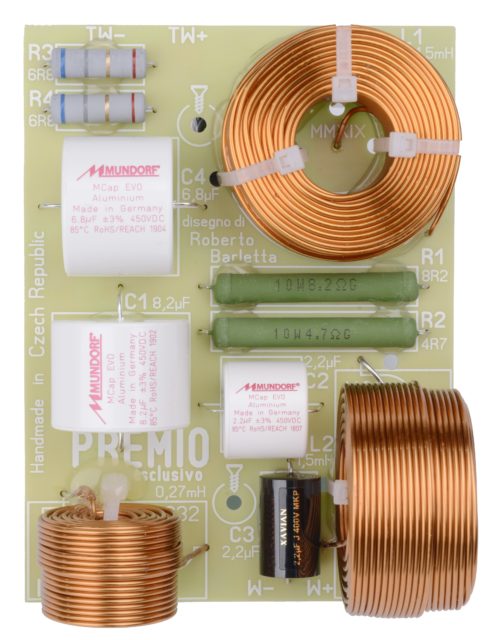
,The stands when bolted to the cabinets forms a complete unit that weighs something like 45 to 50 pounds. This bolting procedure pretty much ensures that the housekeeper is not going to knock over the speakers by accidentally backing into them while vacuuming. I worry all the time about my JMR Bliss speakers which are perched on their Magic Stands and can slide off at the slightest bump. I would be much happier if they were bolted together like the Xavians.
The stands have a large floor plate (11 by 12 inches) that ensures the whole assemby is well stabilized on the floor. The stands are also of the ‘decoupled’ style with felt pads on the bottoms of the floor pieces as well as felt pads on the bolted plate. I prefer this decoupling approach however Xavian includes a spike kit for those so inclined. Personally I avoid using stand spikes.
Positioning
My listening floor area normally measures 14 X 12, with speakers placed on the long wall and with the sweet spot about eight feet in front of the speaker cabinets. These small room dimensions may be a major reason I lean towards intimate speakers. From the very first sessions with the Xavians it was apparent to me that the Premios would need much more open space. Fortunately the above noted floor area opens out into a complemenatry dining area that is also 14 X 12.
To accomodate the Xavians I had to orient them 90 degrees to my normal layout as well as clean out the dining room of furniture. I eventually adjusted them so they were seven feet apart (centre to centre) and the sweet spot was measured at twelve to thirteen feet from the front of the cabinets. This meant that the listening chair was positioned in a place normally held by the dining room table! Ah, the things we all forgo for our crazy audio hobby.
Make no mistake though, the Xavians are happiest in a medium to large floor plan with lots of air and space around them. Fortunately they are front ported and so they were placed about 15 inches from the back wall, which is pretty reasonable.
Tweeter height when the speakers are on the stands is 39″ – just about perfect for a standard chair in order to level the tweeter with the listener’s ears. The grills are magneticaly attached and easily removed which is recommended by the manufacturer. The manual indicates the speakers need around 200 hours of break in to really sing, but the pair I had for review were well broken in and previously used for six months.
Pairing
The binding posts are of superior quality and branded ‘XAVIAN Prague’. I use double strands of OCC (Ohno Continuous Cast copper) for speaker cable and my own DIY interconnects are made from Kimber PBJ, except the phono cable which is an Audio Sensibility Impact copper cable.
The amps used were a Unison Research ‘Simply Italy’ and an Exposure 2010S V1. The CD player used was a Cambridge Audio 640C. The TT was a Gold Note Valore 425 Plus all acrylic model with a Sumiko MM cartridge and the phono stage was a Graham Slee. No streaming, either via a hard drive or on-line, was performed.
Extended Listening
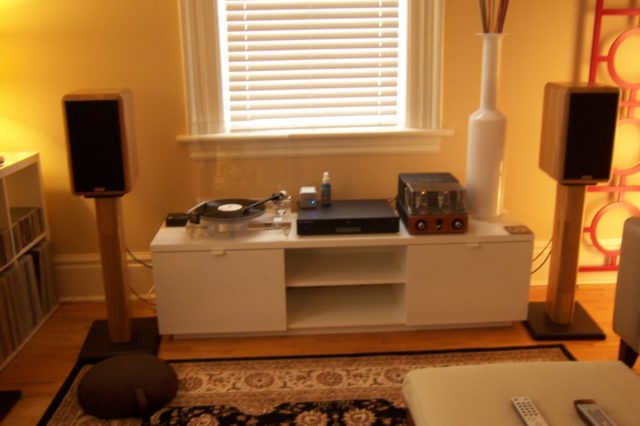 First off, at this price point, these speakers solve all the standard issues that normally present themselves in two way stand mounts. Frequently, either due to design inexperience or to cost cutting, some two way speakers tend to present one or more of these obvious problems: fatiguing tweeters; poor integration of the tweeter and mid-bass unit; cross-over notch distortion issues; incomplete voice matching of the tweeter and mid-bass unit as well as poor bass response indicating bass extension anomalies such as ‘one note’ bass.
First off, at this price point, these speakers solve all the standard issues that normally present themselves in two way stand mounts. Frequently, either due to design inexperience or to cost cutting, some two way speakers tend to present one or more of these obvious problems: fatiguing tweeters; poor integration of the tweeter and mid-bass unit; cross-over notch distortion issues; incomplete voice matching of the tweeter and mid-bass unit as well as poor bass response indicating bass extension anomalies such as ‘one note’ bass.
The Xavian Premios do not have a single issue regarding any of these common fault categories, but most experienced audiophiles would not expect any less given their cost.
The sound field is seamless and flows out of the speakers effortlessly. Even in the (enlarged) 14 X 24 foot room I found I was only running them at the 9 o’clock to 9:30 position on a Unison twelve watt per channel single ended EL34 tube amp. Average output would have been about 80 db and that was plenty loud by my indoor standards.
Lows, mids and highs
The bass output is surprisingly effortless and smooth with great extension and with lots of note variation and accuracy. The treble is totally free of fatigue even in marathon listening sessions of several hours. The integration of voicing between the two drivers is beyond criticism. From the first few notes, I played they just seemed harmonically coherent and right.
There are correspondingly high levels of inner detail revealed and the soundstage is wide and deep with very good articulation of independent instruments. The sweet listening position is several feet wide which can accomodate critical listening across say the width of a chesterfield or a pair of large easy chairs. This is a nice bonus. Unlike close-field listening (one sweet spot), the resulting sound stage the Xavians throw is listenable across the whole width of the rear of the room.
A big surprise – rhythmic drive
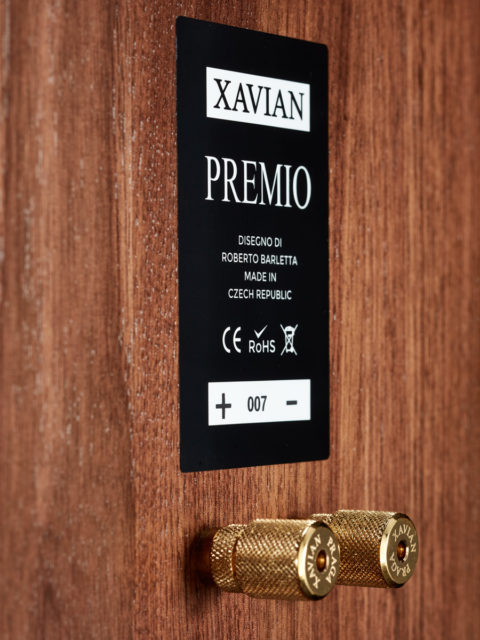 The biggest surprise of all though is the rhythmic drive and pace that these speakers bring to a musical performance. They are, by far, the best two way speakers I have ever heard for replaying tracks from R & B artists and jazz ensembles and also other forms of danceable music. For example Les McCann and Eddie Harris performed live at the Montreaux Jazz Festival in 1969 and this performance was captured on ‘Swiss Movement’. I loved hearing this CD on the Premios which transported me to that stage even though 50-plus years have elapsed.
The biggest surprise of all though is the rhythmic drive and pace that these speakers bring to a musical performance. They are, by far, the best two way speakers I have ever heard for replaying tracks from R & B artists and jazz ensembles and also other forms of danceable music. For example Les McCann and Eddie Harris performed live at the Montreaux Jazz Festival in 1969 and this performance was captured on ‘Swiss Movement’. I loved hearing this CD on the Premios which transported me to that stage even though 50-plus years have elapsed.
The Premios have a way of involving your whole body in the communication of drive and rhythm and they introduce a sense of fun into a lot of music that is just overwhelmingly exciting and quite pleasing. Now who would have thought that speakers built in Prague would be killers at getting you up and in the mood to wiggle, but when all is said and done these speakers love to rock the room!
Every time I would start a listening session I would be led down a path with these speakers where I would begin to think – well, what will I play next? And usually it would be something that really rocked. You can pull out The Rolling Stones ‘Gimme Shelter’ and blast the paint off the walls and you will just be grinning like a cat. Lisa Fischer (20 Feet from Stardom) will be screaming ‘It’s just a shot away’ right on top of Mick Jagger, and you will be in blues rock heaven. Your body will push you to get up and move. It is highly addictive and hugely recommended.
But this essential ‘rock around the clock’ character does not distract from their ability to present more intimate and individualized material like Eva Cassidy or Alison Brown or Alison Krauss. This is only to say that the main forte of these speakers is the drive they bring to the musical tableau. So, when listening to Eva Cassidy, if she launches into an R&B number like Curtis Mayfield’s chestnut ‘People Get Ready’, then my ears really pick up on the timing and pace and I just put the pen aside.
Surprise # 2
The second surprise was also intriguing. On a sunny but cold Sunday morning I switched over to RIAA and vinyl. The change was immediately apparent and I thought, oh boy, here we go!
First of all the sweet spot immediately shifted to only ten or eleven feet from the speaker fronts; a huge adjustment in the sound stage. Secondly, the Premios suddenly became intimate speakers, more like my JMRs (see below). Third, the sense of image depth was far more impressive; the image took on a very clear and palpable three dimensional shape.
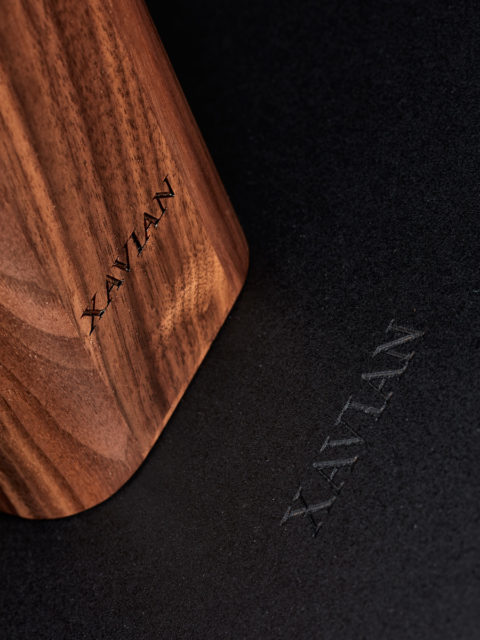 I proceeded to play dozens and dozens of vinyl albums, running through track after track that I have heard many times before. Returning to the artists Les MacCann and Eddie Harris, as noted above, I played their vinyl follow up album (to Montreaux) called ‘Second Movement’ and it was rendered beautifully by the Premios. I was stunned by the sheer musical force of these speakers and I had to push myself away from them from time to time to get a few other things done. But always, after a few minutes, I was drawn back into the listening room by the cohesive sound flowing out of the Premios.
I proceeded to play dozens and dozens of vinyl albums, running through track after track that I have heard many times before. Returning to the artists Les MacCann and Eddie Harris, as noted above, I played their vinyl follow up album (to Montreaux) called ‘Second Movement’ and it was rendered beautifully by the Premios. I was stunned by the sheer musical force of these speakers and I had to push myself away from them from time to time to get a few other things done. But always, after a few minutes, I was drawn back into the listening room by the cohesive sound flowing out of the Premios.
If anyone had the slightest doubt that vinyl offers the listener a distinctive experience, then that thought should and would be immediately banished upon hearing these specific speakers sing.
Do they offer up shiver moments? They certainly do. For instance one of my all time favourite tracks is by Paddy Keenan who is deemed the ‘John Coltrane’ of the celtic Uilleann pipes. When Paddy’s father died he wrote a slow air in his memory called ‘Johny’s Tune: For the Avalon’.
The tune starts off by Paddy stating the melody on a large low D penny whistle, a very difficult instrument. This opening then segues into a restatment of the theme with the celtic pipes soaring. I was so smitten by this track when played through the Xavians that I had to take a break and go for a walk just to cool my body down.
What’s Up, Doc?
So what was happening that made this long Sunday vinyl session so inspiring? I thought a lot about that. I think the wider separation that is available with the CD format is possibly a negative rather than a plus factor. A phono cartridge will narrow that separation potential by five or more dB, and this collapses the sound stage (just a bit) but also helps to invite the listener into the search for inner details. I think this is a subtle and mostly unconscious process, but it does help us understand why vinyl is thought to be ‘warmer’ and ‘more musical’.

At any rate, getting back to the Premios, they make it clear that CD sound, while spacious, is also less inviting for close listening. In contrast they highlight that vinyl and analogue sources are quite a bit more involving and satisfying and are more suited to close field listening.
Is it possible that only one of these two ‘sound stage presentations’ is right and the other is wrong? This is not really very likely and I do believe they are both right. The resolving power of the Premios just makes the difference betwen CD and vinyl more audibly apparent.
The Premios really bit into me hard when I went over primarily to analogue sources. Their need for a medium size room and their ‘far-field’ character when using CDs allowed me to keep a certain initial distance from absolutely falling for them, but the close-field character of their vinyl sound stage speaks directly to my own subjective biases. I was captivated.
Comparisons
Readers will wonder, quite naturally, how they compare or stack up against my reference pair of JMR Bliss Jubillees. This is basically the wrong question. The essential character of these two very different speakers could not be more distinct and each is a champ at what it does well. While each will do honest duty at the other’s prime tasks, potential owners should be very clear about what kinds of music they intend to try to reproduce ‘in the main’.
The JMRs are always intimacy seeking speakers. They like the quiet stuff such as single vocalists with a guitar or small ensembles backed by unusual acoustic instruments, such as the celtic Bodhran or Uilleann pipes. In contrast the Xavian Premios are heartier speakers with tremendous drive and articulation.
When you put on a dense blues rock track such as Bob Seger’s ‘Like a Rock’ the Xavians make you want to stand up and cheer. The glissando of the slide guitar solo breaks when contrasted with Bob Seger’s gritty vocals are portrayed in stunning fashion. Often I would say out loud at the final notes of such a track; ‘wow, what a piece of music’.
A sharp contrast
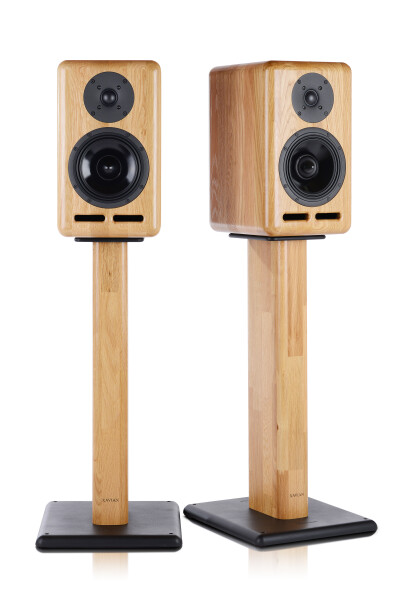
But the two speaker systems are like night and day, or more accurately like the figure/ground distinction found in gestalt psychology. I will try to illuminate this for you. With the JMRs, the sound field compels the listener to focus on a particular ‘voice’. It could be the singer or the piano or the drums or any of the instruments and then the other parts fill in the picture.
You can of course choose to shift your attention from voice to voice but the JMRs compel you to choose a specifc voice for every moment that you listen intently, This is the sort of intimacy they provoke; you are urged sub-consciously to follow a particular voice and they cast over you a kind of aural hypnosis.
In sharp contrast the Xavian Premios always want you to hear the whole sound field as one seamless and coherent event. It doesn’t matter if that sound field is analogue or digital; the Premios always want to put their arms around the whole thing. The essential ‘interplay’ of the instruments and voices is highlighted and the sound field has an ‘organic’ completeness that is hard to fault in any way. It all sounds so satisfying and completely natural.
I therefore often found that live recordings and classical recordings of ensembles were particularly entrancing. In such sessions the musicians are communicating in real time with each other and the Xavians pick this up and highlight its presence. So, while I have focused on their rhythmic drive and pace in my remarks above, make no mstake as they are also natural all-rounders when faced with most recorded material.
Other options
A more apt general comparison to another speaker would be, I think, between the Xavian Premios and the ATC SCM19 speakers, a well known and admired two way stand mount design at about the same price point.
My remarks here are not based on any actual side by side comparison, but I can say that if a buyer is leaning to own the ATC they also need to give themselves a chance to hear the Xavians before deciding. The ATC is a speaker that ‘works with rock’ but is also an excellent all around reproducer. The Xavians are certainly an equal peer and up to that enviable task as well as being more beautifiully crafted.
Summing Up
Returning now to my opening remarks: can a loudspeaker be fun? This pair certainly makes the case. I enthusiastically recommend them to anyone who wants to break out of a sound system that has become sterile and boring. I could happily live with these speakers to the end of my natural days and I will certainly miss them when they go back to the importer.
But I must stress that they do need a medium sized room to really allow them to sing but if so placed they will offer the buyer loads and loads of listening joy. So bring on the music, sit down and watch your body take over your day! It all seems like excellent therapy for these incredibly trying times.
Flash Development
The importer, Stereo Untypical, has recently been informed by the factory that the Premios are now designated as the Xavian Premio Esclusivo. Here is the run down from Xavian:
‘The Premio Esclusivo is a slight evolution … we found a tiny change that slightly improves the sound …. there will be a slightly different looking driver …. and a changed part in the crossover …. but it is 99% identical to the sound of the current Premio.’
So, what this amounts to is the addition of a phase plug to the woofer, a small crossover tweak and a minor drop in sensitivity from 87 to 86dB. Everything else remains identical. The prices remain the same, and even the Premio model serial numbers continue unchanged. The pair auditioned for this reviewed are available at a discount.
Technical Details: These are two way stand mount speakers, with available integrated bolt-on dedicated stands as an option. They have an 8 ohm impedance and are 87/86 dB efficient. They sport a 29mm soft dome tweeter and a 175mm mid/bass unit, both specified by AudioBarletta. Frequency response is 35-30,000 Hz (- 3 dB); the crossover point is 2700 Hz; the weight is 14kg (without stands) and both the cabinets and stands are crafted from ‘mosaic’ Italian oak.
Finishes available: Mosaic Italian Oak – natural, cognac, dark. Lacquer (MDF) – white, black. Marina – maple over oak (extra cost option).
The product page is here. https://www.xavian.cz/product/premio-esclusivo/?lang=en

